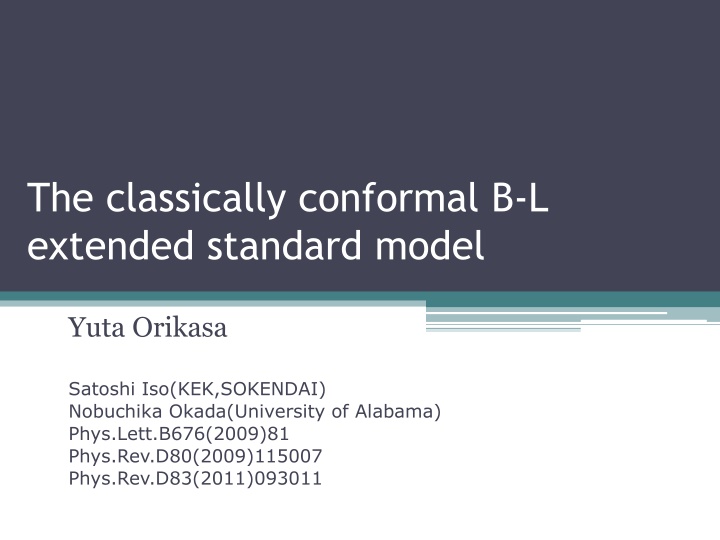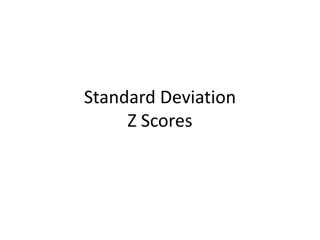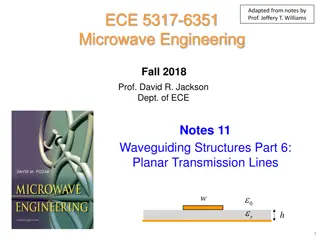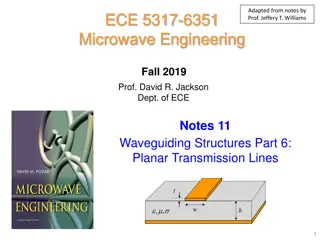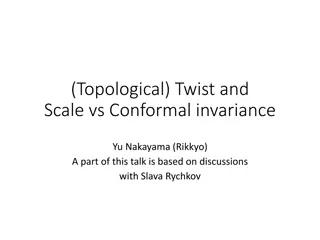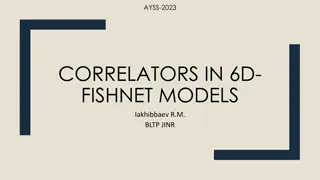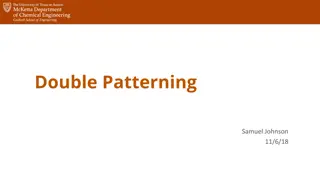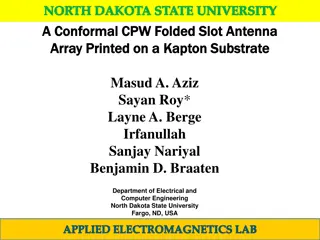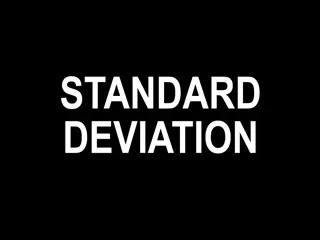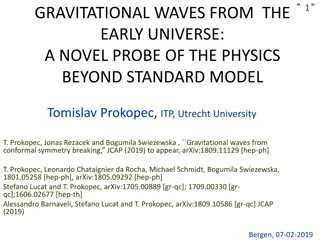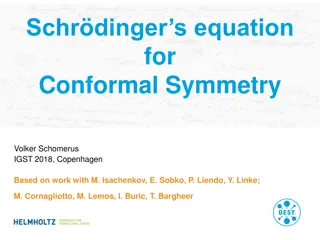Classically Conformal B-L Extended Standard Model: An Overview
Explanation of the classically conformal B-L extended standard model, addressing issues with the Higgs mass term, symmetry breaking, and stability conditions. Explore the proposed minimal B-L extended model, its gauge symmetry, Lagrangian, and potential renormalization group equations.
Download Presentation

Please find below an Image/Link to download the presentation.
The content on the website is provided AS IS for your information and personal use only. It may not be sold, licensed, or shared on other websites without obtaining consent from the author.If you encounter any issues during the download, it is possible that the publisher has removed the file from their server.
You are allowed to download the files provided on this website for personal or commercial use, subject to the condition that they are used lawfully. All files are the property of their respective owners.
The content on the website is provided AS IS for your information and personal use only. It may not be sold, licensed, or shared on other websites without obtaining consent from the author.
E N D
Presentation Transcript
The classically conformal B-L extended standard model Yuta Orikasa Satoshi Iso(KEK,SOKENDAI) Nobuchika Okada(University of Alabama) Phys.Lett.B676(2009)81 Phys.Rev.D80(2009)115007 Phys.Rev.D83(2011)093011
2 Classically conformal SM We assume the classically conformal invariance. This invariance forbids the Higgs mass term. Therefore there is no electroweak symmetry breaking at the classical level. We need to consider origin of the symmetry breaking. Coleman-Weinberg Mechanism (radiative symmetry breaking) Calculate quantum correction
3 However, top quark is heavy, so the stability condition does not satisfy. The effective potential is not stabilized. In the classically conformal SM, due to the large top mass the effective potential is rendered unstable, and CW mechanism does not work. We need to extend SM. We propose classically conformal minimal B-L extended model.
4 Contents Introduction Classically conformal B-L extended Standard Model Phenomenological bound Collider physics Thermal leptogenesis Neutrino oscillation data and resonant leptogenesis Conclusion
5 Classically conformal B-L extended Standard Model
6 Classically conformal B-L extended Model Gauge symmetry New particles right-handed neutrino SM singlet scalar gauge field
7 Lagrangian We assume classically conformal invariance Yukawa sector Dirac Yukawa Majorana Yukawa See-Saw mechanism associates with B-L symmetry breaking.
Potential Renormalization group equations for masses Classically conformal invariance at planck scale
Potential Renormalization group equations for masses Classically conformal invariance at planck scale
Potential Renormalization group equations for quartic couplings Assumption is very small and negative at planck scale
11 In our model, if majorana Yukawa coupling is small, the stability condition satisfies. The potential has non-trivial minimum. B-L symmetry is broken by CW mechanism.
12 Electroweak symmetry breaking Once the B-L symmetry is broken, the SM Higgs doublet mass is generated through the mixing term between H and in the scalar potential. has VEV M. Effective tree-level mass squared is induced. EW symmetry breaking occurs as usual in the SM.
TeV scale B-L model If the B-L gauge coupling and the SM gauge couplings are same order, B-L breaking scale is around a few TeV.
14 Phenomenological bound
15 LEP bound LEP experiments provided a severe constraint. LEP bound
16 Collider physics
17 Z boson at LHC We calculate the dilepton production cross section through the Z boson exchange together with the SM processes mediated by Z boson and photon. Z exchange SM background A clear peak of Z resonance
18 Z boson at ILC (International Linear Collider) We calculate the cross section of the process at the ILC with a collider energy =1 TeV.
19 Excluded by LEP LHC reach ILC reach The figure indicates that if the B-L gauge coupling is not much smaller than the SM gauge couplings, Z boson mass is around a few TeV.
20 Thermal leptogenesis
21 Leptogenesis Wash out for inverse decay suppressed by Z exchange process Initial condition =0.01
22 CP Asymmetry Right-handed Majorana neutrino can decay into lepton and anti-lepton. Vertex contribution Self-energy contribution
23 Majorana mass bound If right-handed neutrinos have a hierarchical mass spectrum ,we can write a CP asymmetry as Baryon asymmetry is The Majorana mass is heavier than .
24 Resonant Leptogenesis The Majorana mass is heavier than ,if the spectrum of Majorana masses has hierarchy. If the Majorana mass of right-handed neutrino is smaller than a few TeV, general leptogenesis can not work. Resonant-Leptogenesis
25 resonant-leptogenesis If two right-handed neutrinos have mass differences comparable to their decay widths , self-energy correction dominate. can be even .
26 Neutrino oscillation data and resonant leptogenesis
27 More realistic case Neutrino oscillation data(2 ) Any model of leptogenesis should reproduce these masses and mixing angles.
28 Assumptions Assumption Only two right-handed neutrino are relevant to neutrino oscillation. Dirac Yukawa matrix is 2 3 matrix. Assumption Neutrino mixing matrix is tri-bimaximal matrix, when CP phase is zero. Assumption Hierarchal neutrino mass spectrum.
29 Baryon asymmetry in our universe
30 Mass difference
31 Mixing angle
32 Conclusion
33 Conclusions We propose the classically conformal minimal B- L model. B-L symmetry and EW symmetry are broken by CW mechanism. Our model naturally predicts B-L breaking scale at TeV. Z boson can be discovered in the near future. Based on assumptions, we analyze neutrino oscillation data and B as a function of a single CP phase. We have found a fixed CP phase can reproduce both all neutrino oscillation data and observed baryon asymmetry.
34 Theoretical bound Planck scale The bound of B-L gauge coupling B-L We impose the condition that B-L gauge coupling does not blow up to Planck scale. scale For TeV scale B-L symmetry breaking, we find
35 Resonant leptogenesis We consider minimal flavor violation At high energy scale, the Majorana masses have same value Flavor symmetry violates the effect of Dirac Yukawa coupling Quantum correction for the Majorana masses
